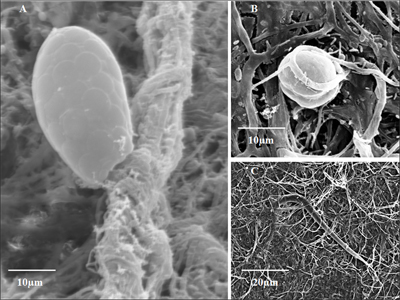Evaluation of nematophagous fungal mycelial growth and interactions with bovine gastrointestinal parasitic nematodes
Authors: Isabela C. Oliveira, Ítalo S. Vieira, Samuel G. Freitas, Artur K. Campos, Adolfo Paz-Silva, Cristiana F. C. Monteiro, Pedro M. de Gives and Jackson V. de Araújo
Ger. J. Vet. Res
2022.
vol. 2, Iss. 2
pp:39-45
Doi: https://doi.org/10.51585/gjvr.2022.2.0035

Abstract:
Previous research has shown an increased action on helminth biological control by fungal combinations. This study characterized the temperature and pH conditions necessary for better mycelial growth of Monacrosporium sinense (SF53) and Pochonia chlamydosporia (VC4). In addition, electron and optical microscopy showed the fungal structures that benefit from their use in the biological control of nematodes and interactions with infective larvae of helminths. Nematode larvae held by P. chlamydosporia mycelium confirm its ability to prey upon larvae stages, despite being classified in the “ovicidal” group. P. chlamydosporia showed the highest growth rate in water agar medium at 20°C, whereas M. sinense showed numerically better growth at 30°C. Fungi did not grow at 35 or 40°C. Surprisingly, the mycelial growth of both isolates was inhibited by temperatures above 35°C for 6 days and resumed when temperatures were reduced to 25°C. The pH observation was important to show that the pH variations in the gastrointestinal tract of bovines will not be harmful to fungi since offering oral formulations to the animals is the most practical way of dispersing fungi in the fecal pats. In-vitro studies facilitate the exploration of biological control agents. The use of nematophagous fungi is a viable solution in the control of gastrointestinal nematodes and needs to be further improved.
Keywords:
Biological control, Environmental conditions, Helminths, Monacrosporium sinense, Pochonia chlamydosporia, Predation
Statistics:
Article Views: 1570
PDF Download: 57